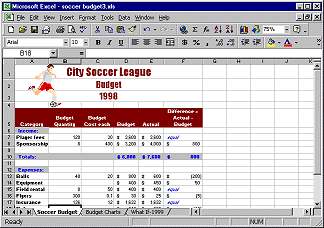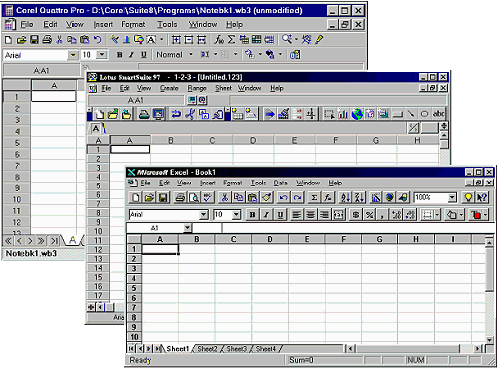 |
The best software for working
with piles of numbers is a spreadsheet program.
Such a program is designed to make it easy to arrange and analyze numbers,
like listing columns of numbers, sorting, doing calculations, and making
charts from the numbers.
In some ways spreadsheet programs (like MS Excel) are
similar to word processing programs (like MS Word) that you are more likely
to have used. In both you can: create titles, type sentences and paragraphs,
arrange data in rows and columns, format numbers and text, set the margins
and orientation of the page, cut, copy, paste, and number the pages. But
each type of software has frequent tasks that are not so common in the other
type. Each has its special choices for printing. Using a program that is
designed for the particular task is worthwhile.
For numbers, spreadsheets are the software of choice.

Spreadsheet software in use (Excel 2000)
|
 |

Where you are:
JegsWorks >
Lessons >
Numbers
Before
you start...
Project 1: Excel Intro
Interface
Select & Navigate
Common Tasks
Summary
Quiz
Exercises
Project 2: Excel Basics
Getting Started
Formatting
AutoFill
Finish
Summary
Quiz
Exercises
Project 3: Format & Arrange
Format Cells
Format Chart
Arrange
Summary
Quiz
Exercises
Project 4: Groups & Formulas
Subtotals
Images & Drawings
Changes & Formulas
Summary
Quiz
Exercises
Project 5: Design
Analysis
What If...
Logical Tests
Sharing Data
Summary
Quiz
Exercises
Search
Glossary
Appendix
  Buy
Download/CD Buy
Download/CD
(no ads) |
|
This set of lessons will teach you to use the most commonly used features
in spreadsheet software. The directions are based on Microsoft Excel 97,
2000, 2002, or 2003. What you learn will help you with other spreadsheet programs, too. The
illustration below shows how similar the major spreadsheet programs look.

Spreadsheet Programs look a lot alike:
Corel Quattro Pro, Lotus 1-2-3, Microsoft Excel
What you need for this tutorial:
- Basic Windows skills: The skills covered in the
Working with Windows lessons- using a mouse
to click, double-click, drag, & right click; parts of a window; moving,
resizing, maximizing, & minimizing a window; scrolling; using the folder
tree; creating and managing folders; naming files; opening a program; opening
and saving files; using dialog boxes; using Help; printing.
- Typing skills: You need to be familiar with the computer
keyboard and have some skill in typing to do these exercises in a reasonable
amount of time.
- Word processing experience: The directions assume that you have
at least some experience with creating documents with a word processor.
You will need the basic skills: entering, deleting, and moving text; choosing
a font, font size, font color; headers & footers, etc. Word processing is
covered in Working with Words.
- Resource files: Files that you need to
create the documents in the projects are provided for download in a
zip file and are also available online separately. Your instructor may have put
these files on your computer already.
To get these resource files,  click on the following link to download a zipped set of files: click on the following link to download a zipped set of files:
resources-numbers.zip
A download dialog will appear. Choose "Save this program
to a disk" if you want to unzip later. Choose Open to let Windows or your own zipping software unzip the files. Choose a folder on your hard drive for the extracted files.
To extract later, find the zipped file in an Explorer window and double-click it. Windows or your own zipping software will then unzip it.
Duplicate files: Some of the resource files have duplicates in different Office file formats. Be careful to choose the file that the directions tells you to use.
- Removable File Storage: USB drive or several floppy disks
You
need removable storage for a working copy and a backup copy of your
documents.
If you have a computer of your own, keep an up-to-date
copy of your work on your home computer, too. Start good backup habits
early and you won't kick yourself later when your files are lost or
corrupted.
USB drive: Recommended
Called by many different names: flash drive, flash pen, thumb
drive, key drive, jump drive, and mini-USB drive. A USB drive is an excellent choice
for storing your class work. Your data is much safer on a USB drive than
on a floppy disk.
Before you buy:
Check the following for both the classroom computer AND your home
computer-
- Computer does have USB ports.
- You are allowed to use one of the USB ports.
- You can physically get to the USB port.
Some are on the the back of the computer case.
- Operating system will recognize a USB drive.
Windows 2000, XP, and Me will automatically recognize your USB drive.
For Win95 and Win98, you must install drivers.
- Physical arrangement of USB ports - Are they side by
side? one above the other?
Some USB drives are wider or thicker than others and may not fit all
port arrangements, especially if a neighboring USB port has something plugged into it.
Many drives come with a short extension cable.
If you do not have a computer at home, consider buying 2 USB
drives so that you can use one to keep a backup copy of your work. Don't
lose them both at the same time!
Floppy disks: Cheaper; Not as reliable
You will need
at least

 two blank 3½"
floppy disks at a time to store the documents you create. One you
will use to save your documents as you work and on the other you will make
a backup copy of the first disk. Keep a third blank floppy on hand
as a spare in case of floppy disasters. two blank 3½"
floppy disks at a time to store the documents you create. One you
will use to save your documents as you work and on the other you will make
a backup copy of the first disk. Keep a third blank floppy on hand
as a spare in case of floppy disasters.
You'll need more than 2 floppy disks if you don't delete any
of the documents you create. After you have put more than one
document on the floppy, keep that spare blank floppy disk handy. It is no
fun at all to do a lot of work and then find that the changed file won't fit on
the disk!
Floppy disks are cheap and handy but it is easy to lose
the data on them from magnetic damage and physical damage when you are
carrying them around all day. Be careful and have several backup copies.
More on caring for
floppy disks and caring for data
 How to
handle a full disk How to
handle a full disk
 The exercises often build on documents
you have already created. Do not delete your exercises until you have
finished all the projects. The exercises often build on documents
you have already created. Do not delete your exercises until you have
finished all the projects.
- Spreadsheet Software: To create spreadsheets you use a spreadsheet
program like MS Excel, Corel Quattro Pro, or Lotus 123. All spreadsheet
programs have some basic similarities. They vary considerably in what special
features they include, just as word processors do. If you are not using
Excel 97, Excel 2000, Excel 2002, or Excel 2003, some of the directions for the projects
and exercises will not work for you. In that case, use your software's Help
files to find out if there is an equivalent method or tool. Even Excel 95,
which is much more like Excel 97 than Word 95 is like Word 97, does not
handle everything quite like Excel 97 does. The differences in Excel 2000/2002/2003
are mostly in the interface changes that are part of all Office 2000 and
Office XP applications.
Icons
 A footprint marks the hands-on topics, where you are to follow Step-by-Step
directions.
A footprint marks the hands-on topics, where you are to follow Step-by-Step
directions.
 marks a tip
- something you might find useful to know. marks a tip
- something you might find useful to know.
 marks
a warning about possible problems. marks
a warning about possible problems.
Disclaimer: All names, addresses, and phone numbers
used in the lessons and exercises are fiction! Any similarity to a real person,
business, or place is a coincidence.
The author cannot be held responsible for any damage to hardware, software,
or data resulting from your attempts to follow the directions.
 
~~ 1 Cor. 10:31 ...whatever you do, do
it all for the glory of God. ~~
Last updated:
02 May 2012 |

![]()